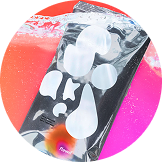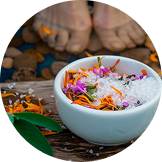You might already be well aware of the role magnesium plays in the body. This mineral influences more than 300 biochemical reactions, and yet, so many people are deficient.
This can lead to a heightened stress response, fatigue, irritability, poor sleep, muscle cramps, and more. While there is no shortage of oral magnesium supplements, these may not offer the benefits you’re hoping for. Unfortunately, magnesium has poor absorption orally.
That being said, does magnesium soak into the skin better than it would through your digestive system? As a matter of fact, this is the BEST way to get your magnesium needs covered! This is known as transdermal magnesium supplementation.
Learn more about how it works below and more specifically how you can start reaping the benefits of transdermal magnesium yourself. We make it easy with our expertly crafted magnesium bath soak selection here at Flewd Stresscare - find your soak today!
Why Magnesium is Such an Essential Mineral
Before we dive deeper into transdermal magnesium you should be aware of just how important it is if you aren’t already. Let’s look at its most prominent roles below and the signs of deficiency.
Magnesium’s Role in Vital Body Functions
We mentioned that this mineral plays a part in more than 300 different processes earlier, but what are some of the most essential?
One is energy production, helping your body convert food (nutrients) into fuel at the cellular level. Magnesium also supports muscle and nerve function by regulating calcium, potassium, and sodium levels in cells, preventing cramps and spasms.
Beyond muscle health, magnesium promotes heart health by maintaining steady heart rhythms and blood pressure levels. It even aids in DNA and protein synthesis, making it a critical component in tissue repair and growth processes.
Magnesium also helps regulate cortisol production, a stress hormone, and contributes to serotonin production, the neurotransmitter responsible for mood balance.
On top of all this magnesium supports melatonin regulation, which is essential for maintaining a proper sleep cycle and ensuring your body and mind recover each night.
Common Symptoms of Magnesium Deficiency
It’s no surprise you’ll notice a magnesium deficiency given all the crucial interactions it has in the body. Some of the most common systems include muscle cramps, twitches, and spasms. This is because of its role in muscle function.
However, deficiency can also manifest itself in the form of fatigue and low energy levels as your body’s energy production system isn’t operating efficiently. Other symptoms include increased irritability, stress, and difficulty sleeping.
But in the long run, a magnesium deficiency might lead to more serious health issues like high blood pressure, irregular heart rhythms, and even an increased risk of osteoporosis due to impaired calcium regulation.
The Problem With Oral Magnesium Intake
You’d think avoiding magnesium deficiency is as simple as incorporating a supplement into your wellness routine or eating a diet rich in magnesium-heavy foods. It’s not that simple, unfortunately. Here’s why oral magnesium intake through diet or supplementation isn’t enough.
Limited Absorption
The biggest issue with taking magnesium orally is that most of it ends up getting lost in the digestive process. Bioavailability is low across the board, but many supplements are comprised of lower-quality magnesium which makes this issue more pronounced.
For example, magnesium oxide is one of the most common forms, yet it has one of the lowest absorption rates at just around 4%. Whether you’re taking pills or powder, most of this will pass through as waste.
There are factors influencing just how much magnesium you’re able to uptake orally, such as gut health, age, and dietary habits. Those with digestive issues like irritable bowel syndrome (IBS) or Crohn's disease often struggle with absorbing magnesium even more than others.
However, the limited absorption is just half of why this isn’t the approach we suggest…
Digestive Issues and Other Side Effects
If you’ve tried magnesium supplements in the past you’re probably all too familiar with the discomfort they can cause - from diarrhea to cramping and bloating.
The problem can be traced back to the low uptake of oral magnesium. You have to compensate by taking higher doses, which can put a strain on your digestive system.
While sometimes the natural laxative effect of oral magnesium supplements can help those who are constipated, most of the time, it’s a nuisance. So, does magnesium soak into the skin better than it does through your digestive system?
Does Magnesium Soak Into the Skin? Overview of Transdermal Magnesium Uptake
Like we said already, yes - magnesium DOES soak into the skin, and this is the BEST way to combat deficiency and reap all the benefits this mineral has to offer.
Why Transdermal Magnesium Supplementation is Far Superior
So, how does magnesium soak into the skin? This is known as transdermal absorption, the process of absorbing substances through the skin directly into the bloodstream rather than through the digestive system.
Whether you’re soaking in a magnesium bath or applying a balm, the ingredients will pass through the outer layer of skin (the epidermis) and into the bloodstream. This allows for much more direct delivery to cells and tissues that need it.
The improved bioavailability is the primary reason transdermal magnesium supplements are preferred to their oral counterparts. This method is more efficient and reduces the risk of gastrointestinal discomfort, such as bloating or diarrhea, that can occur with oral supplements.
But, there’s also the ability to target specific areas of your body where magnesium is needed most. Say you have sore muscles - immersing yourself in a warm soak for 15 minutes gets the magnesium directly into the tissues that are aching for rapid relief.
This makes it an excellent option for athletes, people with chronic pain, or those simply looking to reduce stress without the drawbacks of oral supplements.
What Type of Magnesium is Best Transdermally?
It’s clear that transdermal magnesium supplements are superior, but not all magnesium is created equal in general. There are many different sources you can choose from, but they have varying bioavailability levels.
Magnesium chloride is considered the best form of magnesium for transdermal use for its high bioavailability compared to other forms, such as magnesium sulfate (commonly known as Epsom salt).
While magnesium sulfate is popular, it’s simply less efficient. Why would you settle for less than the best when it comes to your health and wellness? You can learn more about magnesium soak vs epsom salt in our blog if you’d like.
How to Soak Magnesium Into the Skin to Maximize Benefits and Overcome Deficiency
Making the most of your transdermal magnesium involves choosing the right formulation for your unique needs, understanding the optimal soak time, and incorporating a bit of pre/post-soak care. Here are the best practices for magnesium soaks.
Picking the Perfect Magnesium Soak
You already know that magnesium chloride is the best option for transdermal absorption - but let’s get more specific.
Whether you’re looking for a homemade bath soak for aches and pains or a healing bath soak recipe to boost your immune system, you can tailor the formulation accordingly.
Think about what you’re struggling with the most. You can (and probably will) come up with more than one thing if you’re suffering from magnesium deficiency, like insomnia, aches, stress, etc.
From there, you can figure out what other ingredients you need in your magnesium soak. There are so many vitamins, minerals, essential oils, and nootropics worth exploring.
But whether you’re looking for an anxiety bath soak or muscle bath soak, stress relief bath soak, or anything in between, we’ve got something just for you at Flewd Stresscare. More on that in a moment.
Best Practices for Soaking
Using a bath soak is easy. Just fill your tub with warm water (between 92-98°F) - notice we said warm, not hot.
But, how does magnesium soak into the skin in the bathtub? The warm water helps open your pores for better absorption without dehydrating yourself or being uncomfortable.
Then, empty the packet of your chosen soak, or dump 1-2 cups of pure magnesium chloride flakes into the tub. Mix the water up and hop in.
Figuring out how long to soak in magnesium bath is up to you, but a good rule of thumb is to give the ingredients at least 15 minutes to work their magic. Longer is fine if you want to continue indulging in the ultimate relaxation.
Enhancing Absorption With Pre-Soak Preparation
There are a few things you can do before the soak to maximize absorption. Exfoliating your skin gently beforehand removes dead skin cells and opens pores for better penetration. You can use a dry brush or a mild exfoliating scrub to prepare your skin.
Of course, you should always be well-hydrated before you enter the tub. Magnesium can be slightly dehydrating itself.
Post-Soak Practices
Many prefer to rinse off after their soak, and depending on the specific soak you use, this should be part of your post-soak routine. It’s not necessary with Flewd Stresscare since we use all-natural ingredients, but you still can if you’d like.
In fact, we suggest gently patting your skin dry and letting the magnesium stay on your skin afterward to continue absorbing through the epidermis.
Those with dry skin can follow up with a magnesium-rich moisturizer or lotion to lock in hydration while further enhancing magnesium uptake.
Just as with the pre-soak protocol, make sure you drink plenty of water (ideally with electrolytes) after the soak as well. This will support the detoxification process and replenish any fluids you lost.
Start Soaking Up the Benefits With Flewd Stresscare!
All that’s left to do at this point is start soaking up the benefits of transdermal magnesium yourself, and you’re already in the right place. Flewd Stresscare has formulated a variety of solutions tailored to specific ailments, including:
- Sads Smashing Soak: Includes vitamins B3 and B6 with nootropic lithium to lift mood, regulate serotonin, and ease emotional fatigue.
- Anxiety Destroying Soak: Combines complex B vitamins and zinc to calm nerves, reduce anxious thoughts, and promote mental clarity.
- Ache Erasing Soak: Packed with vitamins C and D alongside omega-3s to reduce inflammation and relieve muscle soreness.
- Insomnia Ending Soak: Uses vitamins A and E, plus L-carnitine, to calm your mind and prepare your body for better sleep.
- Panic Crushing Soak: Formulated with nootropic boron and omega-3s to balance stress hormones and reduce feelings of panic.
- Rage Squashing Soak: Includes vitamin B12 and chromium to help stabilize mood swings and reduce spikes of anger or irritability.
Each is formulated around magnesium chloride, the most bioavailable form, for maximum results. They’re all non-toxic, vegan, cruelty-free, and free from harmful additives, just natural healing and wellness!
As we wrap this guide up with a few parting thoughts below, we invite you to join more than 100,000 happy customers and counting who have made Flewd Stresscare an integral part of their wellness regimens. Order yours today and feel the difference firsthand!
Closing Thoughts on Transdermal Magnesium
So, does magnesium soak into the skin? Not only is this an effective approach to addressing magnesium deficiency, it’s the best way to go about it.
It bypasses the digestive system which not only leads to greater efficiency but minimizes the harmful side effects associated with oral consumption, like cramps, diarrhea, and more.
There’s no better way to harness the power of transdermal magnesium than right here at Flewd Stresscare with our natural, expertly crafted soaks. So, discover the transformative benefits of transdermal magnesium with our specialized formulations today!

























































